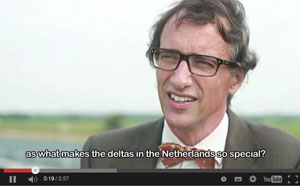Joint expertise for global deltas and ports challenges
The Delft Deltas, Infrastructures & Mobility Initiative (DIMI) aims at interdisciplinary answers to major demographic challenges to create sustainable deltas. Han Meyer, Vice Chairman Professor of Theory and Methods of Urban Design, and Marcel Stive, Professor of Coastal Engineering, outline the key issues:
‘View also this video about DIMI with chairman
Marcel Hertogh’.
International & interdisciplinary cooperation
Han: "The main challenge for the future is
to find smarter and cheaper solutions for deltas throughout the world. Exploiting deltas increases the vulnerability, continuous erosion
of the delta. Climate change and sinking cities cause mayor problem for cities and ports. Large mangrove areas in delta regions in Southeast Asia are also vulnerable to climate change and human-induced change. Salt water flows in freshwater areas."
Field of innovation
Marcel: "A solution needs to be found so that these regions can be continually regenerated. First, through strengthening international networks at the TU Delft. DIMI is a field of innovation for developing connectivity that facilitates international collaboration and stimulates interdisciplinary approach.
Cities in Asia, Africa and South America are facing problems that we have faced in The Netherlands over the last hundred years. We need to provide our expertise so that other nations can capitalise on our knowledge as well as avoid making some of the mistakes we made."
Long-term
Han: "As engineers, we need to create systems that are flexible and smarter, so they provide long-term solutions, not only the short-term and economic benefit that is achieved. We have to find a new way of metropolitan development, inclusive Building with Nature. For example, Jakarta (Indonesia) is sinking, while Africa is undergoing a most intense period of urbanisa-tion. DIMI emphasises an interdisciplinary approach, recognising the broad range of expertise needed in creating sustainable urbanised delta regions.”
Improving delta regions

“Major environmental challenges can be solved through using an interdisciplinary approach and harnessing the forces of nature in order to improve quality of life, whether it be in The Netherlands, or Houston in the U.S. The intense processes of urbanisation present challenges for engineers and urban planners. How can cities, delta regions remain as safe and liveable places to inhabit?
Creatively
The experts at DIMI realise that an inter-disciplinary approach is needed to improve the life and ecology of urbanised deltas. Delta and port regions are undergoing intense processes of urbanisation. Thus, it is the responsibility of engineers and urban planners to solve problems creatively and in more economic and productive ways.
Brainstorm
The conference ‘Deltas and Ports for the Future’ is a progression from ‘DIMI on Tour 2015’. This was a series of six meetings which was used to brainstorm and to test ideas, theories and to garner a broad range of input from experts in different fields.
Galveston Bay near Houston, Texas, is one of many projects where TU Delft expertise has been used to generate designs that both protect Houston and help the ecology. There are many such challenges worldwide – in Asia, in the Americas, but also in Europe - due to economic, demographic factors and climate change.”
HAN MEYER
Building with nature

“The purpose of Building with Nature is to
add value to keep deltas healthy through a combination of good design and incorporation
of natural elements. The challenge is to improve both life in the urbanised delta and the natural context. The Maasvlakte, an expansion of the harbour of Rotterdam on sea on a created island, is a good example. Building with Nature means using natural systems to protect and enhance the lives of people in cities.
'Building with Nature' is introduced and used more and more over the last decades, but stems from a long time ago: as early as 800-900AD people in the north of The Netherlands were using natural techniques to protect themselves from nature. It exists next to the hard reinforce-ment solutions, where the Dutch have a strong reputation – e.g. the Zuiderzeewerken.
Building with Nature has been emphasised
as a key element of engineering and urban planning since the 1970s and has become
a fundamental principle of DIMI's research projects. The philosophy of Building with Nature guides DIMI's pursuit to creating flexible, sustainable and socially responsible solutions to problems faced by urbanised delta regions.
Dynamic
Solutions need to be 'dynamic'. Rather than using 'hard reinforcement', in the case of Dutch coastal regions, it is more beneficial – when there is the possibility - to use what is naturally found – such as sand: this material can be used to protect the coast and maintain a dynamic position in relation to sea-level. Hard reinforce-ment on the other hand is static and becomes problematic over-time.
Principles such as this guide us against making decisions to allow for coastal development. By thinking big in the short-term, we are able to provide more economically viable solutions.”
MARCEL STIVE

HAN MEYER (L.) AND MARCEL STIVE




